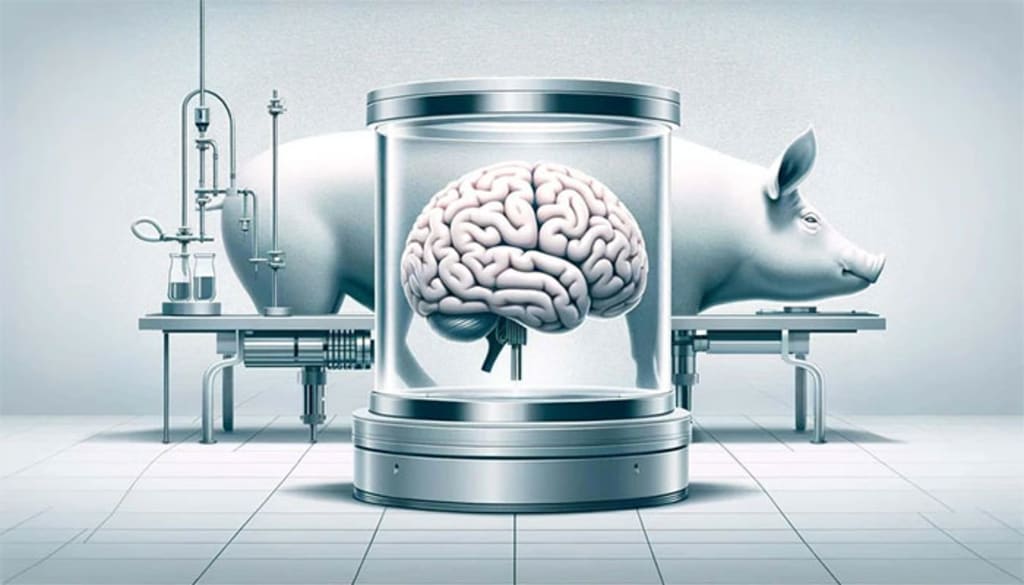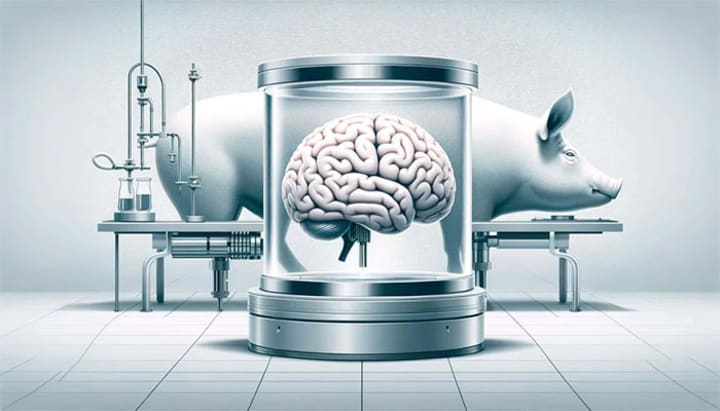Scientists successfully kept a pig's brain alive for 5 hours without a body
The research team invented a device that can separate the brain from the rest of the body and simulate the pumping process of a real heart, helping to nourish the brain outside for 5 hours.

The research team invented a device that can separate the brain from the rest of the body and simulate the pumping process of a real heart, helping to nourish the brain outside for 5 hours.
Developed by scientists at the University of Texas Southwestern Medical Center (UT), the system is capable of isolating the brain from the rest of the body, using a super-smart “artificial blood pump” that takes care of supplying blood to the brain.
It's called an extracorporeal pulse circulatory control (EPCC) device - which gives the brain the nutrients, oxygen and blood it needs to keep functioning.

The device will undergo further testing to evaluate its effectiveness in clinical conditions.
Method of isolating the brain from the body
“The new method helps develop a research direction that focuses on the brain independently of the body, allowing humans to solve physiological problems in an unprecedented way,” said Dr. Juan Pascual, who led the research team.
Besides paving the way for studying the human brain without the interference of other bodily functions, the research could also inspire the design of more complex heart-lung machines that mimic the way the human heart circulates blood to the brain.
According to BGR, the brain is a very mysterious organ. The brain is the control center of many body processes such as heart rate, breathing, and sleep-wake cycles. Therefore, it will be significantly affected by various physiological factors such as blood sugar levels, blood pressure, and oxygen levels.

Pig brains survive without a body.
Developing a device that can isolate the brain from the body's influences is a major step forward. It could be the key to unlocking deeper insights into how the human brain works.
According to a scientific paper published in Nature, the EPCC system works by redirecting blood supply to the brain through a pump that can regulate variables such as pressure, volume, temperature, oxygen and nutrient levels.
This allows researchers to maintain stable brain activity over long periods of time. Isolation allows for precise blood flow to the brain, allowing for a better understanding of how blood affects brain function without interference from the body.
Specifically, Dr. Pascual and his team used this technology to better understand the effects of hypoglycemia in the pig brain, independent of the body’s compensatory mechanisms. In theory, this approach provides a better understanding of how changes in glucose levels directly affect brain function.
Furthermore, the EPCC device pumps blood in a pulsatile manner, more closely mimicking the human heart than current heart-lung machines. This approach has the potential to reduce the brain-related side effects often associated with these machines. With the patent now in place, the device will undergo further testing to evaluate its effectiveness in clinical settings.
Strange experiments with the brain
In fact, this wasn’t the first time an animal’s brain had been removed from its body. One of the earliest experiments was conducted in 1857, when French physician Charles-Édouard Brown-Séquard decapitated a dog. Ten minutes later, he attached four rubber tubes to the carotid artery of the dog’s head and injected oxygenated blood. A few minutes later, the dog’s eyes and muscles began to move again.

Many experiments have been performed on animal brains.
An even more bizarre experiment was performed by American neurosurgeon Robert J. White, who removed a monkey's brain and attached it to the circulatory system of another animal. He called this method a whole-body transplant. White also dreamed that one day it would help people with hemiplegia and quadriplegia to prolong their lives through surgery.
The monkey survived for eight days. During that time, it could see, smell, and move its mouth, but it had no control over its new body. Surgery alone would not be able to reconnect the monkey’s head to the hundreds of millions of nerves in its severed spinal cord.
However, the latest discovery by scientists at the University of Texas on pig brains is still interesting because it lays the foundation for another crazy idea, that a person can live in a foreign body, as long as blood is circulating.
This was certainly not the goal of the research, but it does hint at the possibility that brain isolation could one day be applied to humans.
About the Creator
HK Decor
Telling stories my heart needs to tell <3 life is a journey, not a competition
If you like what you read, feel free to leave a tip,I would love some feedback
https://sites.google.com/view/hk-decor/trang-ch%E1%BB%A7
Enjoyed the story? Support the Creator.
Subscribe for free to receive all their stories in your feed. You could also pledge your support or give them a one-off tip, letting them know you appreciate their work.






Comments
There are no comments for this story
Be the first to respond and start the conversation.